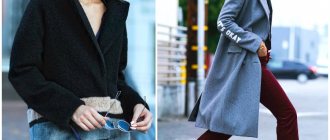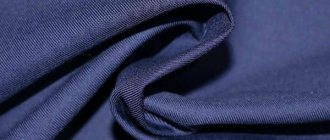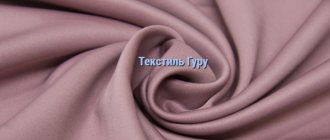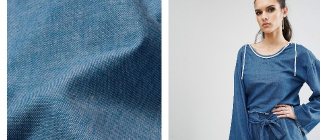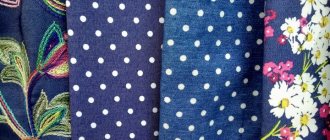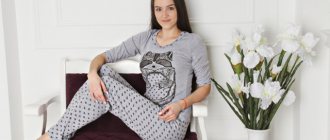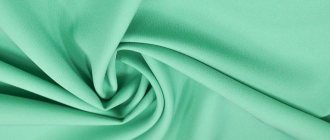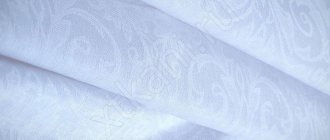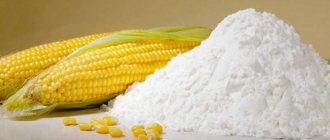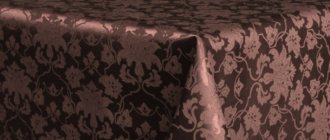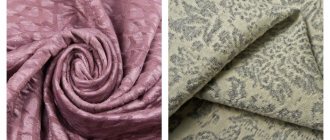Drape fabric: you can see a photo and description of the material in our article, as well as get a detailed description of the fibrous composition.
Drape is a dense and heavy woolen fabric, which is made from cloth spinning yarn with a complex interweaving of threads. Translated from French, the word “drap” means “cloth”.
What kind of drape fabric is this?
The history of drape begins in France at the end of the 18th century. At that time, weaving looms had just appeared on which it was possible to make dense, thick fabric. Initially, drape was a durable material made of coarse wool, which protected well from bad weather.
Translated from French, the word drap means “cloth”.
Modern drape is wool fabric containing synthetic additives. It is plastic and easy to use, allowing you to give the product different shapes. The material is multilayer, created by double joining of threads and subsequent pressing. Sheep or alpaca wool is used for production.
The pure wool material is heavy and retains its shape well. It does not wrinkle during wear and is abrasion resistant. Pure wool drape does not stretch. If synthetic fiber is added to drape fabric, it becomes elastic. Nylon, viscose or nylon are used as synthetic additives.
Properties of drape that make it very popular:
- does not allow heat to pass through;
- allows air to pass through to the body;
- does not wear out for a long time;
- does not absorb foreign odors;
- does not require complex care.
Drape clothing is universal and adds elegance to the wearer's image. The peculiarity of drape fabric is that the back and front sides have the same appearance. This allows you to re-face things. The disadvantages of drape fabric include its electrification. The smallest hairs will settle on the coat. This type of clothing is not suitable for pet owners.
Another wool material is cashmere. It also comes in pure wool and with the addition of synthetics.
Cashmere and drape differ in properties. Cashmere is thin, elastic, and stretches well. Only pure wool cashmere is suitable for making outerwear. Semi-synthetic does not retain heat well.
View this post on Instagram
Posted by ModaTex (@moda.tex) Dec 19, 2021 at 5:02 PST
Positive and negative properties
Drape fabric has a long list of advantages. Among them:
- breathability;
- high density;
- wear resistance;
- keeps its shape perfectly;
- easy to care for;
- softness of the material;
- practicality;
- availability;
- pleasant pricing policy.
The disadvantages include:
- shrinks when washed;
- It is not recommended to wear in snow and rain;
- Once creases have formed, they are difficult to get rid of.
As you can see, there are more positive properties than disadvantages. This indicates the high quality of the fabric.
Types of drape
Drape is a material that now exists in several varieties. There are differences in fabric composition, density, hairiness and color. Single-layer drape is used to make suits. Demi-season coats are made from one-and-a-half-layer coats, and winter coats are made from two-layer coats.
Italian drape is of high quality. Good fabric is produced by factories in Russia, England, Germany, and Turkey. Russian manufacturers of high-quality drape clothing - Elite, Victoria, Mama Belle.
Pure wool
The most expensive and high-quality variety. It is made from 100% selected wool using the double weaving method. It has high wear resistance and retains its shape for a long time. It is also allowed to include no more than 15% of chemically recovered wool fibers.
Synthetic
Consists of polyester, artificial wool threads. In appearance it is similar to natural drape, but does not have its properties. Cheap fabric, used mainly for making toys and crafts. Upholstered furniture is upholstered with canvas.
Melange
The variety differs in the way it is painted. If the classic drape has a single color, then the melange threads are dyed in two or more colors. Beautiful patterns are created using colored threads. In appearance, this drape resembles tweed.
Unlinted
The surface of this material is smooth. It is obtained by the method of satin or sateen weave of threads. Non-pile fabric has high wear resistance. It is convenient to cut, since you do not need to adhere to the direction of the fibers. Used primarily for sewing men's clothing.
Ratin
The pile is arranged in diagonal stripes. This fabric is made using the twill weave method. Then the material is processed by a press, its surface acquires a herringbone structure. Ratin is an expensive fabric, produced mainly in gray or black colors.
bottle
Patterns are formed from the pile by special arrangement of the fibers. This is a heavy material consisting of merino wool and Tsigai sheep. It has increased rigidity and is used for making outerwear.
Areas of use
- Classic and avant-garde suits, elegant coats, stylish caps, scarves for men, women and children are made from drape.
- Windproof suits and workwear are made from mixed fabrics.
- The material is easy to work with and makes original accessories and fun toys.
- Drape is used in modern interior design and the furniture industry. They decorate windows and cover sofas and armchairs.
Scope of application of drape fabric
The main use of drape is the manufacture of outerwear. A drape coat is an indispensable part of both women's and men's wardrobes. Regardless of the style, a drape coat gives its owner solidity.
A drape coat can be classic, youth, or sporty. It is worn every day to work or just for special occasions. It depends on the style and design of the clothing.
Drape can be combined with any materials. It is combined with corduroy, leather, natural or faux fur. Original combinations are obtained with knitwear, silk, chiffon.
The thin material forms beautiful folds. This allows you to create elegant things with drapery and voluminous details. The coat is combined with wide belts and does not puff up.
Watch an example of cutting and sewing a coat in the video:
Watch the video on how to decate fabric before cutting to prevent it from shrinking in the future:
In addition to making clothes, drape is used in the production of toys and interior elements. In the furniture industry, it is used to make upholstery for chairs, armchairs, and sofas.
Watch the video on how to make a beautiful rose from drape:
Selections of men's coats:
Where and how the material is used
Drape fabric, the photo of which is presented below, is actively used for sewing outerwear, especially coats.
In addition, the following is made from canvas:
- hats;
- toys;
- furniture covers;
- souvenirs;
- accessories;
- products for room decoration.
Drape is a fashionable material used to make clothes in different styles:
- classic;
- casual;
- romantic (ratin and melange drape);
- military;
- eclectic (unlined).
- grunge
Outfits made from drape are noticed every year at world fashion shows.
Drape care
Caring for drape clothing is easy. Once a season, clean the product with a brush and soap foam. As it gets dirty during wear, remove dust and hairs with a damp brush.
It is not recommended to wash clothes yourself in a washing machine; if they are heavily soiled, you should take the item to the dry cleaner. During the off-season, the coat is stored in a special case.
Suits and skirts made of thin single-layer drape can be machine washed. A delicate wash cycle is used; powder or gel should be used for woolen items. After washing, the product should be laid out on a flat surface until completely dry.
Sun drying is prohibited. Wrinkles may appear on items if they are not dried properly. It is difficult to get rid of them; use a steamer or iron the product through damp gauze.
See how to care for your coat:
General characteristics
According to the description, the drape fabric is a double-sided fabric. For the front side, only wool threads are used. In this case, the material will last for decades. Nitron, viscose, and nylon can be added to the reverse side.
Material properties:
- It does not have good stretchability, but it keeps its shape perfectly.
- Real drape fabric is uniform. There is no difference between the front and back sides.
- High density.
- Easy to care for.
- Convenient for sewing.
Need to remember! Cloth items shrink significantly after washing. Therefore, it is better to take them to dry cleaning.
Useful tips for choosing fabric and sewing a coat
Before purchasing fabric, consult with a craftsman to determine how much fabric is needed for a particular style. The number of meters is determined after measurements. When choosing a product, pay attention to the quality of tailoring. There should be no unevenness on the surface, and all seams should be perfectly smooth. The lining should also be made of high-quality fabric. And batting or synthetic winterizer is used as insulation.
It is better to sew a winter coat from materials with a loose structure that retain heat well. You can choose wool fabric with the addition of nitron or lavsan.
- For demi-season models, drape, velor or tweed are more suitable;
- For a coat with an oval or straight silhouette, choose a material with a textured and piled surface;
- For a fitted or narrow coat, smooth and thin materials are suitable. It can be cashmere, corduroy or thin drape.
I hope that my recommendations will help you choose quality material. Dress nicely and don't freeze!
Subscribe to my blog updates and share information with your friends. See you again, dear readers!
Silk group
Coat silk fabrics, despite their lightness, have the necessary heat-protective properties to keep you warm in cool summer weather. Most often, elegant coats are made from them:
- Brocade . Heavy shiny. Produced by weaving silk and metallized threads. It has a luxurious appearance, high density, and rigidity.
- Velvet . Soft, dense with silky pile. They are made from silk fibers, but the addition of cotton and synthetic threads is quite acceptable. Mixing different types of fibers allows you to improve the properties while maintaining a luxurious effect.
- Jacquard . Dense with a large relief pattern. The pattern is obtained by complex weaving of threads that differ in color, thickness and composition. Silk jacquard looks luxurious; mixed fabrics with the addition of cotton and synthetic fibers look no less impressive.
History of appearance
Drape first appeared in France at the end of the 18th century. As a result of industrial development, weaving machinery became available that could produce such material. The name “drape” itself is also of French origin and means “cloth”. At first it was cloth made of coarse wool, thick, durable and voluminous. The canvas with a rolled, smooth surface provided protection in bad weather.
Modern samples of drape fabrics contain additives of synthetic fibers or are made from regenerated wool. They have become thinner, more pliable and more flexible compared to previously produced versions.
What is the difference, cashmere and drape
With the development of the textile industry, competitors appeared for woolen fabric. One of them is cashmere. To understand that information about the main differences will help better.
- You need to pay attention to the density. Cashmere is softer, lighter and more elastic, while the drape is heavy and dense. Loose coats and capes are sewn from the first.
- Cashmere is warmer only in its classic form, when it consists of 100% goat down. Compromise options made from a mixture of wool and synthetics, which are often found on store shelves, do not provide reliable protection from the cold and wear out quickly.
Rules for choosing materials for coats
The decision of what fabric the coat should be made of is influenced, first of all, by whether it is demi-season or winter. When choosing a demi-season option, you should pay attention to moisture-resistant types.
They may not be very dense and may not be decorated with lining.
If the coat is winter, then its inside should consist of three layers. This is the material itself, a layer of insulation and a beautiful lining. The outer material should be wear-resistant, strong and very warm.
Do not forget to look at the composition of the product before purchasing.
One of the best options is cashmere, which is made from the undercoat of cashmere goats. This material is very expensive, so it is mixed with wool options.
Wool is used for many quality fabrics: tweed, boucle or drape. The characteristics can be judged by the fiber weaves. It would be great if there were no visible gaps between them. Would you like some advice on how to determine the quality of matter?
To do this, squeeze it in your palm and hold it for about 30 seconds. If it is very wrinkled, then it contains a large amount of synthetics. And such material is unlikely to heat well.
The range produced by the textile industry is characterized by enormous diversity. To choose a decent option, you need to understand the varieties. Let's try to do this.
How to choose the right fabric?
Now on display you can find a huge variety of fabrics suitable for sewing coats, which retain heat well and have increased wear resistance. Therefore, before you go shopping for fabric, you need to decide who you will sew for and for what weather. Oddly enough, but fabrics can be intended for children, women and men, and are also divided into winter, demi-season and summer.
Of course, the fabrics are mainly intended for the autumn-spring period, as well as for winter. The fabric for a demi-season coat should have special properties, since such a product does not involve insulation, which means that the fabrics must have high thermal insulation. Coats for the winter season consist of the outer fabric itself, followed by wind-resistant, insulating and cushioning fabric. That is why winter fabric should not have special thermal insulation. It needs to be light, beautiful and water-repellent.
As for summer coats, anthers and raincoats, the main criterion for selection will be water-repellent property.
Features of manufacturing and composition
The widely known drape fabric was first produced in France. Despite the fact that in literal translation this name coincides with the French word “cloth”, the manufacturing technology of this material is completely different. It consists of a special method of weaving the weft and warp, in which the threads are arranged in one and a half or two layers.
Initially, such material was made only from high-quality wool; it was double-sided, so after prolonged wear the drape coat was ripped open and sewn again with the wrong side up.
Modern drape fabrics are divided according to the manufacturing method:
- a relatively light and thin fabric of twill or satin type, a square meter of which weighs from 400 to 500 g;
- with a two-face weave of one and a half layers, a denser material is obtained (from 500 to 600 g/sq.m);
- classic two-layer drape weighs over 700 g/sq.m and is the most expensive.
With double weaving, to reduce cost, the formation of the wrong side is made with raw materials of poorer quality. To do this, a thin thread is combined with a coarser one or regenerated wool fiber is used. In this case, the structure of the canvas becomes less dense, and the reverse side is not as smooth and beautiful as the face, although they will practically not differ in appearance. Acrylic, polyamide, nitron, viscose, etc. are added to mixed fabrics. The presence of synthetic or artificial fibers worsens the heat-insulating properties of the drape, making it looser and less wear-resistant, but affordable. Fully synthetic fabric is inexpensive, but it only imitates natural drape; a coat made from it will not keep you warm and will not last long.
Types of materials
There are different types of jackets. They differ in fabric composition and impregnation. Almost each of these fabrics can be called raincoat.
Duspo
The material is produced by plain weave of polyamide fibers. The surface is glossy, shiny or velvety. There are many shades.
The cushion fabric protects from wind and moisture. Breathable, durable and strong. It drapes without problems and does not wrinkle. This allows the fabric to be used for the manufacture of any style.
The textiles are resistant to cold and sunlight and are used for sewing ski and mountaineering suits. This is a “family” material: it is used to make children’s and adult clothing, and things for dogs.
Pronto
Windproof fabric for sewing children's and teenagers' jackets, sportswear. Repels water and dirt, hygienic and environmentally friendly material. Made with plain weave. Plainly dyed material with a large number of colors.
The fabric is made from polyester fibers. Impregnated with various types of polyurethane impregnation. It is durable but lightweight. It's easy to care for, no ironing required.
Scottish matting oxford
It received this name because it was first produced in Scotland. It is made by plain weaving of fiber bundles. Because of this, the description is similar to matting: embossed fabric with convex cells.
Oxford is made from cotton mixed with nylon or polyamide. It is durable, windproof and water-repellent. It is additionally coated with a waterproof solution. Oxford is easy to dye, so there are many shades available.
Greta
Produced using a twill weave of polyester and cotton fibers. Due to this weaving, the inside is completely natural, and the outer part is chemical. The result is a comfortable and hygienic jacket fabric.
Greta is used to make outerwear for newborn babies and older children. It is used to make uniforms for emergency workers, law enforcement agencies and the food industry.
If you treat the material with waterproof and oil-repellent impregnation, you will get work clothes for the military and gas station employees. This fabric is easy to dye, even in camouflage colors.
Taslan
This fine ribbed material is made from rep weave polyamide fibers. Reinforced threads made of nylon or nylon are added. The fabric is suitable for a winter or demi-season jacket.
Taslan does not allow water to pass through, repels organic contaminants, is lightweight, and dries quickly. Does not have a greenhouse effect, resistant to long-term exposure to ultraviolet radiation.
For windbreaker
Different types of windbreakers are sewn from the following types of fabrics:
- Polyester - almost does not wrinkle, repels water, protects from wind. Does not allow the skin to breathe, so it is not suitable for the summer season and sports activities.
- Membrane material is used for sports and ski products. It allows air to pass through and protects from the wind. Does not allow you to freeze, repels moisture, rain, snow.
- Nylon is a smooth, shiny fabric. Used for making sports windbreakers. They allow air to pass through, but protect from the wind. These products are inexpensive.
Cotton fibers are often added to windbreaker fabrics, approximately 40%.
On padding polyester
For a jacket made from padding polyester, polyester or raincoat fabric is usually used. The fabric is stitched, resulting in a diamond-shaped or square fabric. It's called quilted.
For long walks, choose long products that are the most insulated. Shorter and lighter jackets are suitable for everyday wear.
Bologna
It is made with a dense weave of thin polymer fiber. Bolognese material is almost impervious to air and moisture. Usually dark colors, as it is used in wet and dirty weather.
It is durable and light, practical, does not wrinkle. Resistant to mold, acids, and alkaline solutions. Bologna fabric is damaged when exposed to ultraviolet rays. This is an Italian fabric, first made in the city of Bologna.
For parkas
It is made from cotton, polyamide, polyester, nylon. Often it is a mixture of these fibers. The fabric for the parka should be warm and protect from wind and frost. Winter and demi-season parks are made from it.
The impregnated material repels water and dirt and is practical. It is easy to care for. This textile has good thermal insulation properties.
For warm jackets
Warm, windproof and waterproof material is required. It must be wear-resistant and dense. The fabric for jackets with insulation must be durable.
Natural fabric is not suitable. It is not resistant to moisture and in rain or snow the insulation inside will get wet. Therefore, for warm jackets, synthetic fabric is needed: polyester, nylon, microfiber, taslan. Additionally, it is impregnated with a special water-repellent composition.
Reversible Jackets
They are made from various materials: duspo, polyester, bologna, membrane, taslan, raincoat fabric. A reversible jacket can be made from different materials on both sides to give them different textures. Typically, the most varied shades are used to make such products. You can even find long coats with double-sided prints on sale.
Jacket materials are made from different fabrics and impregnated with different compounds depending on the purpose. To choose a suitable product, you need to study the composition of the fabric and impregnation.
© 2021 textiletrend.ru
Features of choice
A demi-season coat requires a light but dense fabric base - ideally textured. Cashmere and gabardine are the best options for cool summer or early autumn.
For the rainy mid-autumn, mixed fabrics are suitable - with increased density, strength and water resistance.
In winter, it is better to give preference to soft and cozy fabrics, for example, pile fabrics. Fluffy pile forms an air layer, which increases the heat-saving properties of the material.
How to choose warm fabric for a coat? Watch the video:
